Shiojiri’s High School cum Winery: Student Winemaking
Sep 19,2024
Shiojiri’s High School cum Winery: Student Winemaking
Sep 19,2024


Shiojiri, Nagano Prefecture, is the cradle of Nagano wine. The city’s Kikyogahara district, also known as Kikyogahara Wine Valley, is a notable winegrowing region dotted with seventeen wineries. It is also the home of Shiojiri Shigakukan High School, where students have been making wine since it was licensed to produce “fruit-based alcoholic beverages” in 1943. The school offers classes in growing grapes and wine production. Students get to make wine themselves as they learn. Their rare wine is highly regarded for its fine taste and quality. Indeed, it’s even won prizes at wine contests in Japan. So how do the students go about making wine? To find out, we dropped in on the class and talked to the man who teaches it, Tanaka Shigeyasu.
It was a glorious July day. In the vineyards on the grounds of Shiojiri Shigakukan High School, the vines were laden with clusters of yellow-green Merlot. The grapes would subsequently grow larger and turn light purple before assuming a deep reddish-purple hue. They would then be ready to pick. But that was still a month away.
It was the day of a hands-on growing class. Some twenty students were gathered in front of a small whiteboard in one corner of the covered walkway between school wings. They were listening attentively to what the teacher was saying. Each was attired in whatever working clothes they liked, ranging from a bare T-shirt and shorts to full protection against the sun including overalls, hat, and arm coverings. All, however, had a bag at their hip packed with implements, including a pair of well-used pruning scissors. They were certainly dressed for the job. These students had elected to take Wine Production, part of the school’s Agricultural Science program. So what kind of curriculum does the school offer?
“Besides regular subjects like Japanese, English, and math, students can from second year also choose specialized subjects like commerce, social work, and agriculture as part of the general studies program. For example, there’s what’s called the Agricultural Science program, which is further divided into various subjects like orchard farming, flower growing, and vegetable farming. These are full-year classes, which we call ‘courses.’ Wine Production is one of them.” So explains Mr. Tanaka, who teaches the course along with several other instructors. It covers the entire process from growing grapes to making wine.
Over a hundred courses are offered. Winemaking has some sixty spaces available in second and third year combined, out of a total student body of 590. It’s so popular that enrollees are selected by drawing names. At the typical Japanese high school, students major in either humanities or science. At Shiojiri Shigakukan, however, they’re free to choose whatever subjects suit their aptitudes and interests. This customizable curriculum is unique and appealing to students.
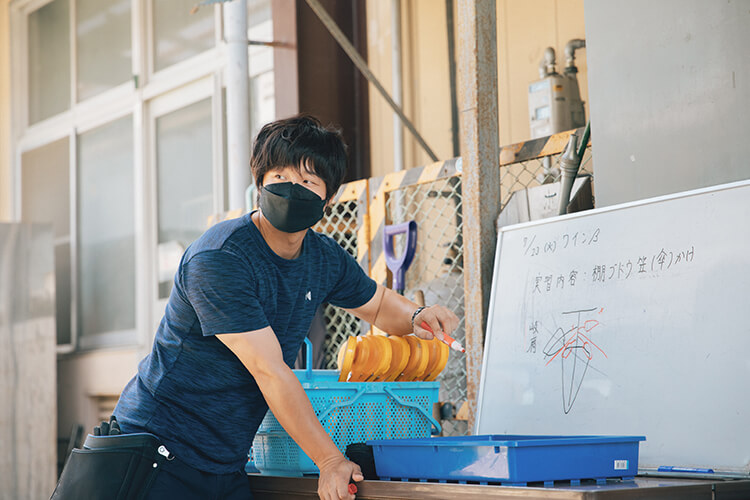
Mr. Tanaka using the whiteboard to explain what the day’s hands-on class would involve. Two teachers supervised the session.
Mr. Tanaka cautioned the group against heat stress; then the hands-on class began. The students headed to the vineyard, step stools in hand. There are two vineyards, both on the school grounds. Together, they cover thirty-three ares (an are being a square measuring ten meters per side). They yield five to six metric tons of grapes per year. Several grape varietals are grown here: Merlot, Cabernet Sauvignon, Concord, Chardonnay, Niagara, and Koshu. Of these, Merlot, the main varietal used to make Shiojiri wine, accounts for 70 percent. The vineyards are of two types. One is “trellised.” Several posts are set up in the vineyard, and wires are extended over a canopy to create a framework or “trellis.” The vines are then trained along the trellis. The other is “bush-trained.” Posts are arranged like a fence, and the vines are planted in rows and supported by wires. This day’s training session took place in the trellised area. What exactly did it involve?
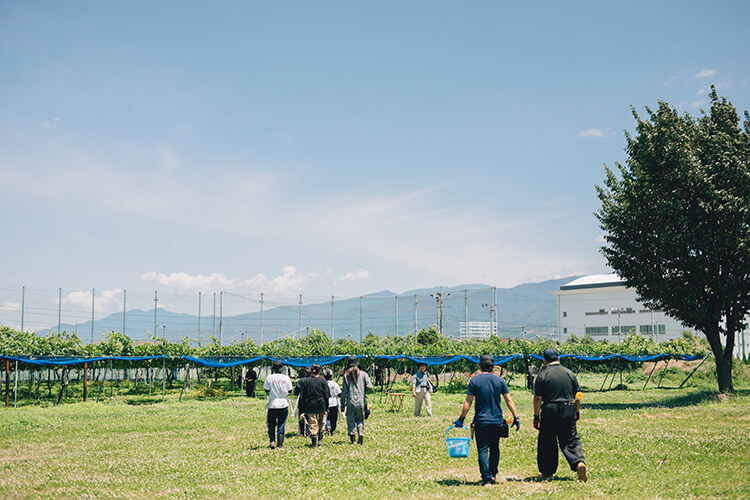
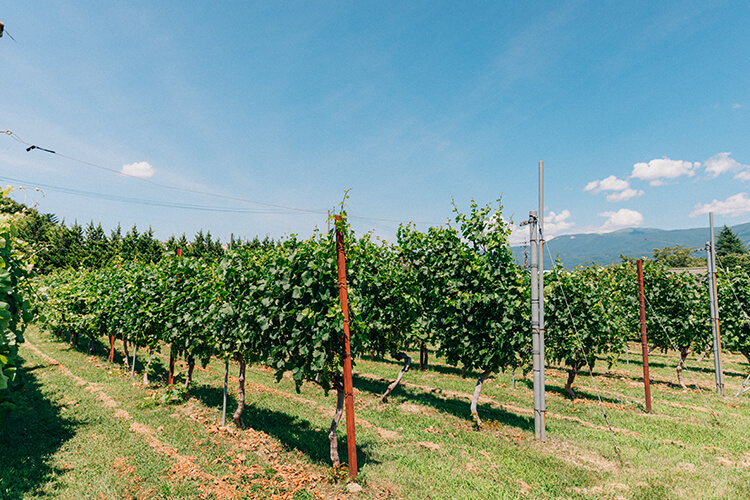
Left: Students heading to the vineyard on the school grounds. There are two vineyards with a total area of 33 ares — a respectable size for a winery.
Right: The bush-trained vineyard.
“What they’re doing today is putting protective covers on the Merlot. These are umbrella-shaped covers made of paper placed over the clusters of grapes. They protect the grapes from disease and insects. Each student is assigned a grapevine, and their nametag is hung on it. It’s their responsibility to look after it. Constantly tending to the same vine causes them to develop an affection for it. Even when there’s no class, they head to the vineyard to tend to their vine. I always tell my students that the grapes are four-fifths of what makes a good wine, so they’re really dedicated.”
Stepping into the vineyard, you notice how the main branch or “cordon” of each vine is trained in a specific direction along the canopy, with the grape clusters growing in a row along the cordon.
“This is called the Smart system, in which the grapes grow in a single row. The grapevine cordons are oriented north-south, and the laterals are arranged at intervals in an east-west direction, with shoots left only on the cordons trained north. This is a labor-saving way to produce grapes with high sugar content while ensuring a reasonably large crop.”
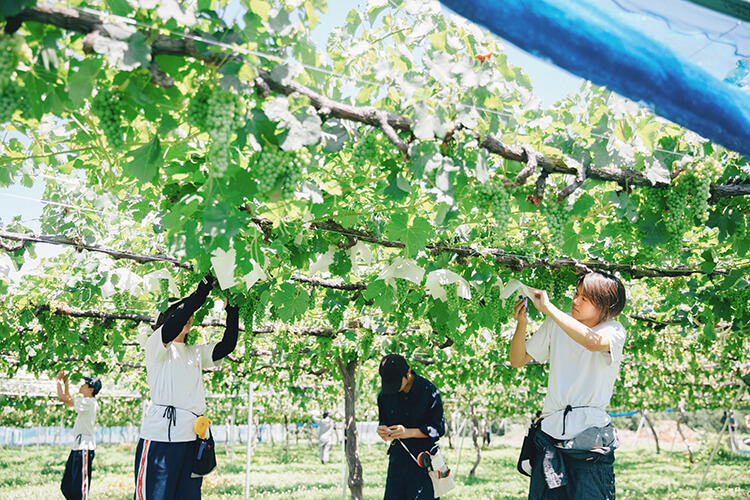
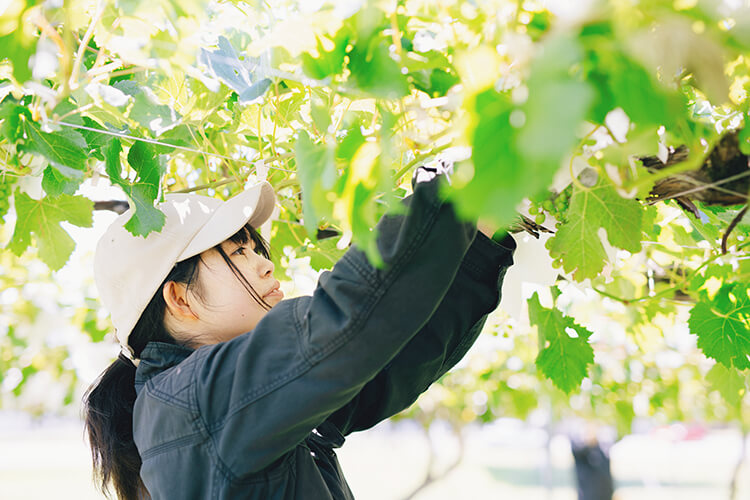
Viticulture involves performing different tasks in each season. Students get to observe how the vines change and grow over the course of the year.
The trellis is about two meters high. You have to stretch your arms to reach the clusters of grapes. Many of the students stood on a step stool as they worked. Some were methodically bagging grape clusters. One was asking the teacher for advice. Several stood motionless staring at the branches of their vine. I asked why. “These two clusters overlap,” said one. “Maybe I should remove one of them.” Another was wondering what to do about their grapes not getting enough sun. There was also a student agonizing over gaps in the grape clusters. I took a look, and there were places along the branch where no grapes were growing. Some of the vines had evidently been damaged by the weather this year.
“In some places vines have been affected by a physiological disorder called ‘flower drop,’ in which they fail to fruit because they’re not properly fertilized. This is the first time I’ve seen it myself. I guess that’s because it rained so much during pollination season. It rained a lot this year, right?”
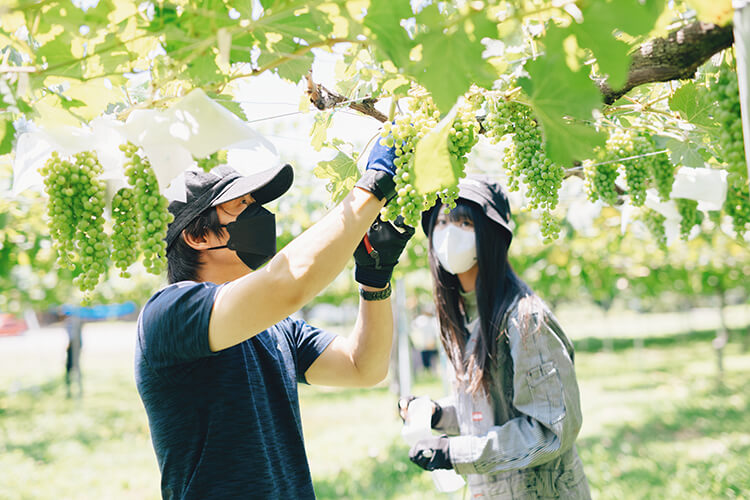

Left: Mr. Tanaka advising a student based on past experience.
Right: Each student is responsible for looking after the vine with their name tag. They develop an affection for it.
In addition, some vines were crushed in a heavy snowstorm in March.
“Viticulture is a struggle against the natural environment. We run into a host of problems throughout the year. But we take precautions against whatever can be foreseen. Every time an issue arises, the students think for themselves and act accordingly. After all, they want to grow good grapes and make good wine.”
The students learn firsthand the agonies and joys of cultivating vines by tending to them throughout the year: training them in the spring; removing unwanted leaves and putting on protective covers during the summer; harvesting the grapes during the fall; and in winter, pruning the vines to ensure balanced growth.
One of the students said to me beamingly, “It’s really rewarding. The more effort you put into tending the vines, the more they thrive. Seeing them grow is like watching your hard work pay off. It’s exhausting but fun.”
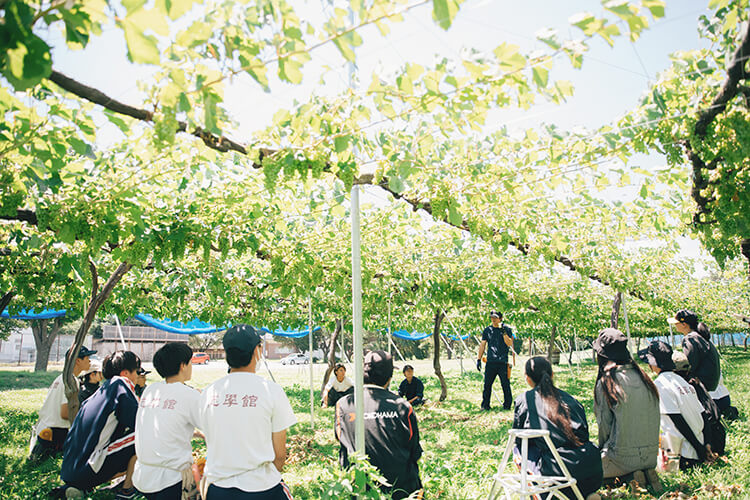
Mr. Tanaka sharing his observations about the condition of the vines. Here he’s describing a disease of vine leaves while passing around an affected leaf to the students.
Mr. Tanaka and the other teachers who give the course aren’t in fact experts in viticulture and winemaking. They study the subject after being assigned to teach it and build up experience as they instruct the students.
“I started out as a rank amateur, to be honest, so first I went to train at vineyards and wineries. I studied with the pros and aped what they did. This is the seventh year I’ve been teaching wine production, but I still have a lot to learn. I feel it’s incumbent on us to maintain rigorous quality standards. After all, our tradition and track record as a winery go all the way back to 1943, even if we’re just making wine as part of the school curriculum. One thing we’re really grateful for is the technical support we get from the city of Shiojiri and local businesses. We even go on study trips to chateaux located overseas [a chateau is a producer with its own vineyards and winery], though we had to restrict our training programs to Japan after Covid struck in 2020. We’ve conducting vineyard and winery training workshops in Bordeaux and Champagne, France, as well as California and, at home, in Obihiro, Yoichi, Sapporo, and Otaru, all in Hokkaido. Professional winemakers have a different level of commitment to their art, and listening to them is inspiring for students. It really fires them up. They come home different people [laughs]. And [Japan’s largest winemaker] Mercian gives special classes for us five times a year. They also help out a good deal with quality control and analytics at the winery.
“Students acquire the requisite knowledge and skills, then. Some may argue that’s not enough, though, since they don’t get to taste the wine. But that makes their eyes and noses all the more acute. After all, color and bouquet are both key factors for a wine. If they choose to pursue a career in winemaking after they graduate, I’m sure they’ll be really good at it.”
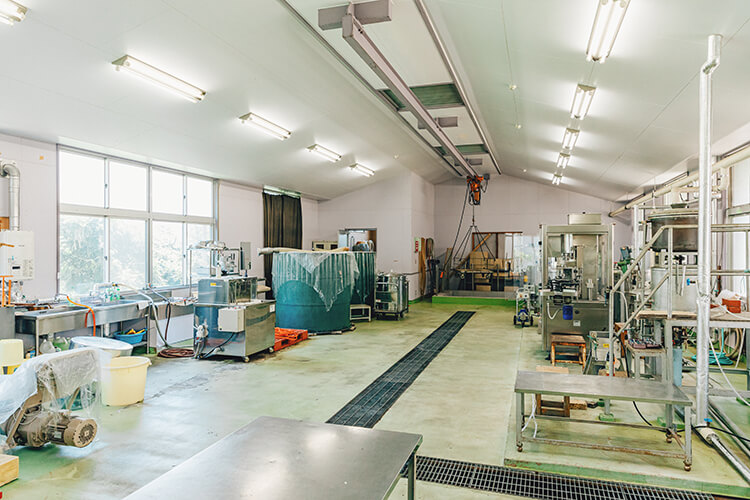
The winemaking facilities inside the school. Students get to make wine in a well-equipped setting.
We only got to see the viticulture part of the course on our visit; we weren’t able to observe a winemaking class. We were, however, shown around the winemaking facilities inside the school building. All the requisite equipment was there, including a press and a vinification tank. In the basement was a well-maintained cellar for aging and storing wine, with rows of barrels. The place was so well equipped it could have been mistaken it for a commercial winery.
Generally speaking, wineries in Japan are required to produce a certain number of bottles of wine per year. To meet that criterion, the school makes at least three thousand bottles per year of red, white, and rosé combined under the brand name “Kikyo Wine.” Plenty of time is taken to age the wine. The Merlot, for example, a red wine, is aged for a year in the barrel and another year in the bottle, for a total of two years. It’s also subject to rigorous quality control.
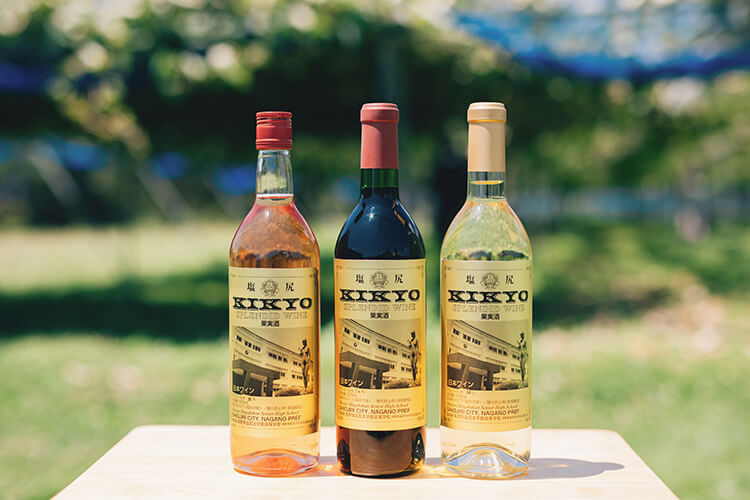
Shiojiri Shigakukan High School’s wine brand Kikyo Wine. The school is depicted on the label.
“We don’t make the wine to sell, of course, but we do put it on sale at an event held once a year at the school festival in July. It’s offered cheap — for about a thousand yen — to students’ family members, people with connections to the school, and local residents.”
The wine is of such high quality that it could easily command a price of five or six thousand yen a bottle, says Mr. Tanaka. The wine sale accordingly attracts long lineups every year.
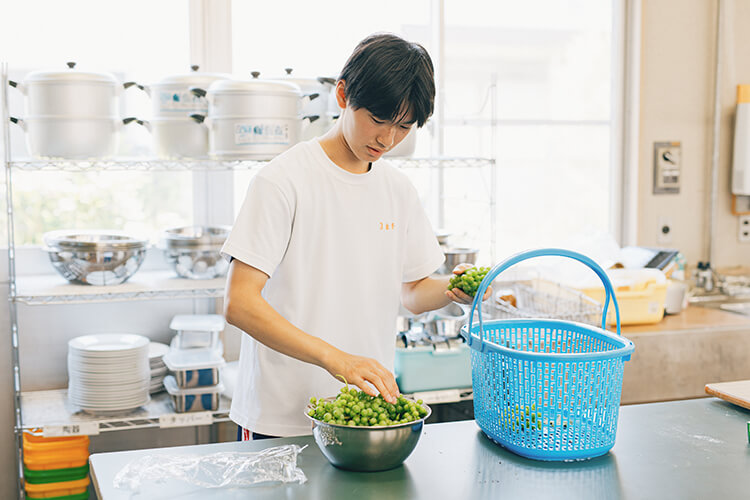

A student who dreams of owning his own vineyard one day. He does his own research while getting advice from the teacher on how to recycle discarded grapes.
Shiojiri Shigakukan High School’s Wine Production course may at first glance appear to be an elite program designed to develop the next generation of winemakers. Students are, however, free to pursue whatever career path they choose upon graduation. They don’t necessarily end up working in the wine industry.
“Some students, of course, do find a job at a winery or somewhere like that. Nothing delights me more than seeing one of them doing well when we visit their workplace on a study tour. Several graduates go into the wine industry every year. But even if they choose another path, having done some serious grape-growing and winemaking in their formative teen years will, I believe, serve them well in other fields, whether it be the food industry, social work, or science. I’m sure the time will come when they look back with pride on having played a part in Shiojiri’s history as a winemaking center.”
Incidentally, on reaching twenty — drinking age in Japan — students receive a free bottle of the vintage they themselves made. They contact the school and come to pick it up in person. Mr. Tanaka always looks forward to seeing his former students now that they’re a bit older. It’s a fair exchange for a lovingly aged two-year-old wine.
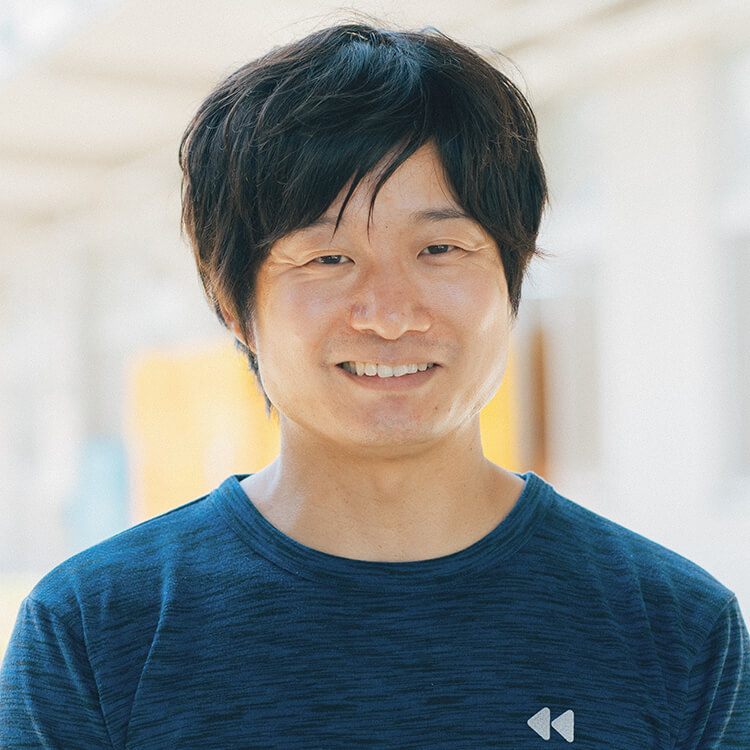
Mr. Tanaka is in his seventh year teaching wine production. He spends his days learning and growing with his students while passing on Shiojiri Shigakukan High School’s winemaking heritage.
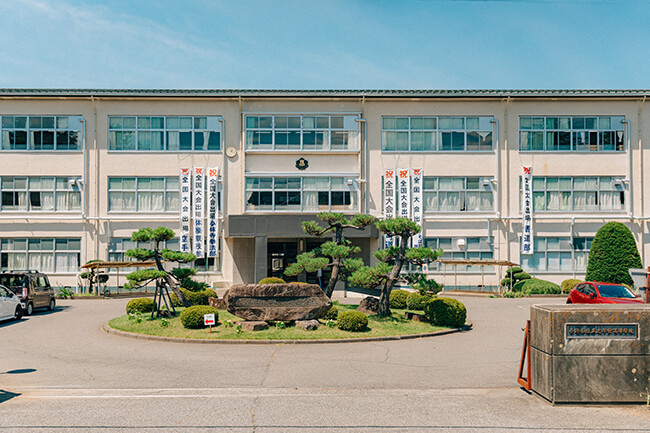
About the High School Winery:
https://sites.google.com/g.nagano-c.ed.jp/boysbeambitious/